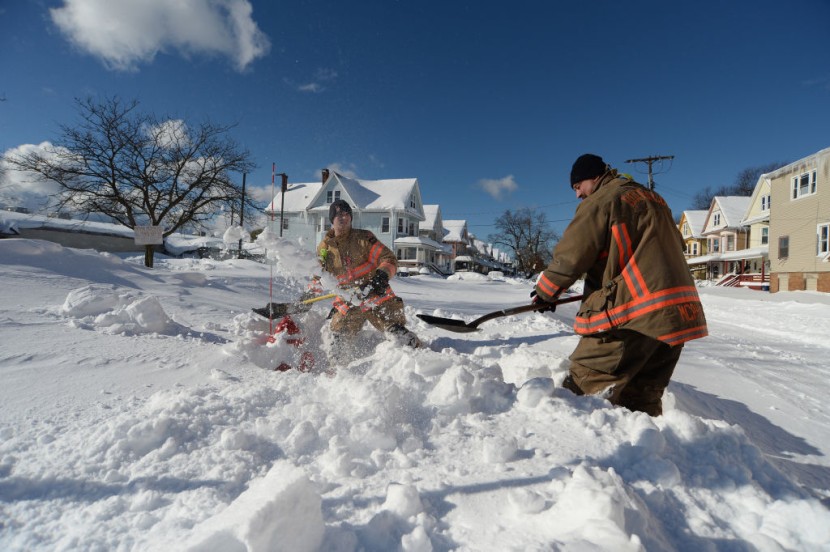
As a countrywide winter storm approaches, temperatures in Colorado and Wyoming are falling to record lows.
Wednesday evening, the temperature in Denver dropped to -9 degrees Fahrenheit from 42 degrees in the afternoon. Wind chill dropped from 32 degrees to -30 degrees within the same time period, as per CNN.
Winter Storm Threatens US Holiday Travel Chaos
According to the National Weather Service in Boulder, a 37-degree decrease in temperature during one hour at Denver International Airport is preliminary the most ever recorded at that site. In seven minutes, the temperature also dropped by 24 degrees.
Wyoming's capital city, Cheyenne, dropped from 43 degrees with a wind chill of 35 degrees at 1:05 p.m. local time to -13 degrees with a wind chill of -42 degrees at 4:00 p.m. That implies the city had a wind chill drop of more than 75 degrees, which reflects how the wind feels.
In addition, the temperature dropped 30 degrees in 10 minutes and a record-breaking 43 degrees in one hour in Cheyenne. Thursday's maximum temperature in Denver is projected to remain below zero, making it the city's coldest day in almost 30 years. Temperatures are expected to drop by as much as 60 degrees from their current levels.
The National Weather Service (NWS) is calling the winter storm approaching Buffalo and western New York before Christmas a "once-in-a-generation" occurrence.
During one of the busiest travel seasons of the year, the majority of the Great Lakes area is under winter storm watches and warnings, prompting the announcement. Per Fox News, Friday will see a flash freeze as a consequence of a "rapid transition from rain to snow with temperatures plummeting into the teens and single digits."
Read Also: Scientists Warn Common Food Dye in Famous Snacks Linked to Bowel Inflammation, Study Says
Winter Storm Preparedness
In recent weeks, Buffalo has been hammered by lake-effect snow. The week before Thanksgiving, a blizzard dumped more than 80 inches of snow on the city's Orchard Park and Hamburg areas. According to 5News Online, AAA offers the following travel suggestions during the holiday season:
1. Preparing your car for hazardous driving conditions
- Remove any snow and ice from the windows, roof, hood, trunk lid, and other covered surfaces of the car. This will lessen danger, as your visibility will rise. In addition, surrounding vehicles will not be dazzled by snow flying off your car.
- Utilize an ice scraper to clear snow and ice from the windshield and all glass, including the side and rear windows. This will increase your capacity to observe other road users that may enter your travel route.
- At least once every week, clean the exterior and interior of your windshield to maximize visibility. If you smoke, frequent cleaning is even more vital.
- Maintain the windshield and rear-window defrosters of your automobile.
- Keep your windshield wipers in good condition. Many motorists replace their tires every six months, particularly before traveling in inclement weather.
2. On the street
- Ensure your headlights are activated. In fact, it is always a good idea to utilize your headlights when driving, as you will boost your visibility in any weather.
- Reduce your speed and provide plenty space for stopping. You should leave at least three times the customary distance between your car and the one in front of you.
- Brake slowly to avoid skidding.
- Never use cruise control on roadways that are damp, snow-covered, or slippery.
- Consider the possibility of icy roadways. Be particularly cautious on bridges and overpasses, as they ice before highways. And even at temperatures above freezing, you may find ice in shaded regions or on exposed roads such as bridges if the weather is moist.
- Be cautious on less trafficked routes, as they may not be cleaned as regularly as other highways.
3. Departing the highway
- If you must pull off the road, you should wait for conditions to improve and then pull as far off the road as possible, preferably beyond the end of a guardrail.
- Pulling into a rest area or parking lot is preferable to stopping on the road's shoulder.
4. Understand When to Brake and Turn
- Certain driving scenarios necessitate immediate action to avoid a crash or collision, especially in wintry conditions, the option to steer versus stop might have drastically different results.
- AAA Missouri suggests steering over braking to prevent an accident in winter-like conditions while going over 25 mph, as maneuvering around an object requires less distance than braking. In slippery circumstances, abrupt braking may result in loss of vehicle control.
- Occasionally, though, steering is not a choice. Braking on slick conditions necessitates a broader field of vision and increased following and stopping distances.
- Plan stopping distances as early as possible, and always look 20 to 30 seconds ahead of your car to ensure that you have the space and time to stop safely.
Maintain Control During a Skid
On slick terrain, even cautious and experienced drivers might lose control. When a car begins to skid, it is essential to remain calm and do the following steps:
- Continue to gaze and drive the vehicle in the desired direction.
- Avoid slamming on the brakes, since this may further unbalance the car and make it more difficult to manage.
Related Article : Magnitude 6.4 Earthquake Leaves Tens of Thousands Without Power, Kills 2 in Northern California
@YouTube









